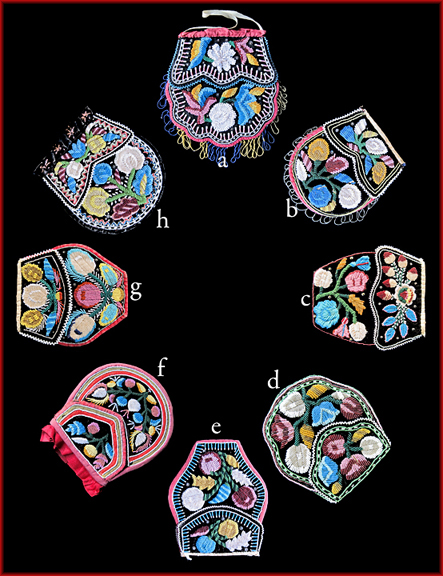During the nineteenth century, the western New York Haudenosaunee, and particularly the Tuscaroras, were on the front lines of the world’s most exciting and emerging tourist market. The Victorians who came to Niagara Falls were fashion conscious, and any stylish dress accessory acquired there - such as a beaded bag - would have to reflect their sense of refinement and good taste.
The beaded bags that the Haudenosaunee produced for the tourist trade are distinctive and changed stylistically over time. These changes occurred gradually but, as a general rule, distinguishable style refinements can be categorized and placed into specific time periods.
Not long after the dawn of the Victorian era, a major design transformation was taking place in Haudenosaunee beadwork. The linear motifs with the prominent geometric and organic patterns from the classic period of Haudenosaunee beadwork gave way to a profusion of floral work such as the examples in this group. The origin of this floral style has long been a topic of discussion among collectors and researchers alike. Evidence suggests it emerged during the late 1830s to the early 1840s, in the waning years of the classic period of Haudenosaunee beadwork.
The floral motifs on these bags became the predominate beadwork style that would be made and sold by the Iroquois during the Victorian period and the overwhelming evidence suggests that they were made in many Haudenosaunee communities. The epicenter for the sale of many of these bags was Niagara Falls so accordingly, they are often referred to as the Niagara floral style.
Museums and private collections are well provided with examples of bags, hats and moccasins in this style that are attributed to the Tuscarora, Seneca, Onondaga, Oneida as well as the Mohawk. The National Museum of the American Indian has close to 100 that are attributed to the Tuscarora alone, with perhaps an equal amount attributed to both the Seneca and the Mohawk. Item 37163 in the New York State Museum, in Albany, is identified by Arthur C. Parker as Tuscarora. Parker was himself a Seneca, born on the Cattaraugus Reservation in western New York in 1881. His grandfather, Nicholas H. Parker was Caroline Parker’s brother so this is firsthand knowledge by a nephew who was a scholar. Item 36665 from the same collection was identified by a different source as Onondaga. Item 11051/235 in the Rochester Museum and Science Center collection is identified as Seneca.
In his monograph on The Iroquois, the anthropologist Frank Speck illustrated a Glengarry hat in this floral style that is from the Grand River Reserve. See: Speck, Cranbrook Institute of Science, bulletin 23, [1945] 1982, page 63.
Tom Hill, a Seneca scholar and the director of the Woodlands Cultural Center in Brantford Ontario identifies one of two hats in this style as Tuscarora, the other as Mohawk. See: Creation’s Journey, Native American Identity and Belief, National Museum of the American Indian, Smithsonian Institution, 1994, page 64.
In her monograph on Iroquois Crafts, Carrie Lyford writes about this floral style: “The Indians were quick to apply their handiwork to table covers, hand bags, pin cushions and other articles brought from Europe, using designs previously developed on such native articles as moccasins and bands for baby cradles. About 1860 they began to embroider floral designs in colored beads arranged to give shaded effects in an apparent copying of foreign decorative art forms. This heavy bead embroidery was much used by the Tuscarora on round ceremonial caps, bags of various shapes, and velvet moccasin cuffs.” In: Iroquois Crafts, United States Department of the Interior, 1945, page 75. And there are many other examples.
